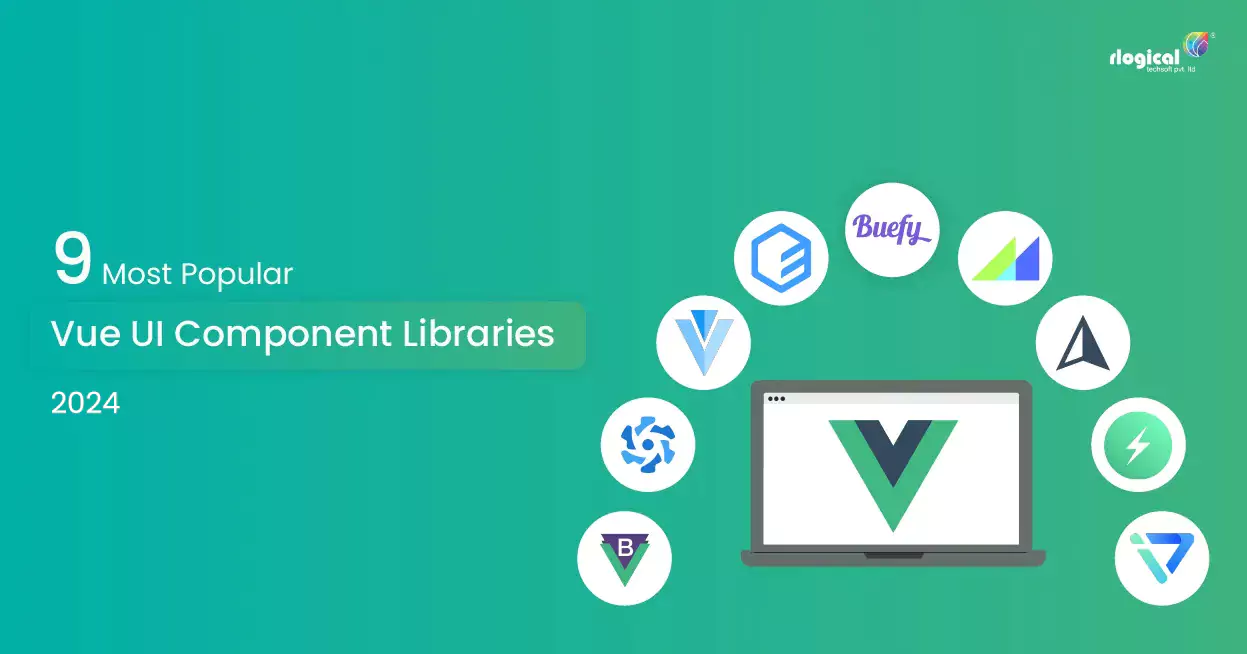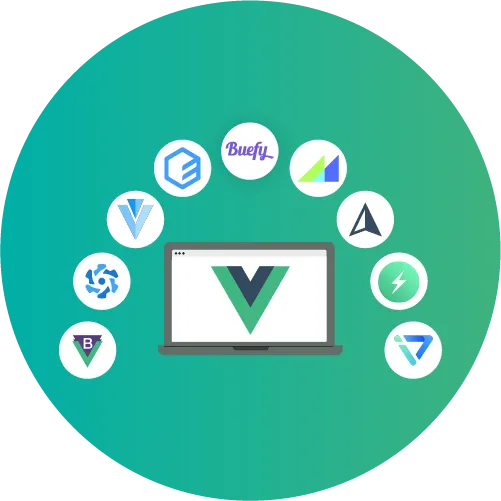
It is very simple to learn and use Vue JS, which makes it quite popular amongst front-end developers at present. This well-known JavaScript library is used for creating dynamic apps on the front end. Vue is considered to be the primary competitor to React and Angular and is used by lots of developers across the globe right now. One notable feature of Vue happens to be its capability of breaking down a webpage into several components, which becomes quite simple with the usage of UI design services. You will come across quite a few UI component libraries to help you create components without any problem whatsoever.
In the following paragraphs, we have talked about some in-demand Vue UI component libraries in 2024.
1. BootstrapVue
BootstrapVue aids in creating highly responsive sites with customizable UI elements, and this helps to make it the most well-known front-end framework on the planet. It offers a grid system as well as UI components for the convenience of the users. It is not difficult to comprehend the documentation, and it is likewise simple to set up.
BootstrapVue provides more than 85 components, several directives, over 45 plug-ins, as well as more than 1000 icons. Apart from this, it offers functional components customized for responsive design and layouts. In a nutshell, it aids in making front-end applications perform faster. You will find it quite simple to master BootstrapVue in case you have adequate experience in Bootstrap, and in this manner, it will be feasible for you to create some fantastic web apps within a short period.
2. Quasar
This is a framework with lots of use cases and a powerful community. Quasar is a performance-based framework that helps to make Vue UIs. Even though the Quasar UI library might seem to depend on Material Design, it is possible to customize it to fit your design system in the long run. This library can support all mobile and desktop browsers.
More than 300 contributors, as well as over 16,000 GitHub stars, speak volumes regarding its popularity at present. One notable thing regarding this framework is that it has the ability to write code only once and deploying it concurrently as a website using only one codebase. Consequently, Quasar will be a fantastic option in case you hire VueJS developers for deploying to several platforms from just one codebase.
3. Vuetify
Being a well-known design language introduced by Google, Vuetify happens to be a framework that is based on Material Design. It comprises UI guidelines for shapes, interactions, cards, as well as various depth effects. This framework allows us to create clean and reusable UI components and is compatible with the SSR (Server Side Rendering) of Vue.
Vuetify aids in customizing the application with dynamic and unique layouts and making use of SASS variables for perfecting the style of the components. Apart from this, it is compatible with Vue CLI-3 and supports all contemporary browsers. This framework likewise offers basic templates for A La Carte, Apache Cordova, Webpack, Electron, NUXT, PWA, as well as Simple HTML.
4. Element
This is a Vue component library intended for designers, developers, and product managers. The primary usage of the Element library is to create desktop applications. This library can boast of having a large community. Although it is mainly customized for creating desktop UIs, it supports features like creating grids and concealing elements depending on the window size.
Although this framework has a major part of the documentation in Chinese, English and Spanish translations are also available. One must go through the internationalization guide before commencing a project, given that the default language happens to be Chinese. At present, it has more than 44k stars on GitHub, which makes it an extremely well-known component library for Vue. The element will be the ideal library for you in case you want to create desktop applications.
5. Buefy
Buefy happens to be a lightweight Vue UI component library that is based on Bulma. It comes with two core principles – to be lightweight and to maintain the simplicity of things. This helps to explain why Bulma and Vue are its only dependencies. Buefy helps to develop visually attractive apps by making use of minimal code. It can be imported either wholly or as single elements. Even though the default version comes with a distinctive appearance, it is possible to customize the framework. It will be feasible to define your sizing rules, brand colors, and so on, thus making personalization simple and fast.
Buefy customizes global variables by making use of Saas, which can be applied throughout the app. This feature, along with the ability to use dynamic elements like sortable tables and progress bars, helps to make Buefy ideal for interactive web apps.
Even though it consists of only more than 40 components, Buefy will be offering responsive UI components which are available readily. At present, this framework can boast of having more than 8k stars on GitHub. Apart from this, more than 30k downloads on NPM every week have been recorded right now. In case you like to create Vue applications with intuitive and simple user interfaces, it will be a sensible idea to make use of Buefy without any problem whatsoever.
Must Read: How to Make a Vue.js Website SEO Friendly?
6. Vue Material
This one is a lightweight and simple Vue UI component library which is responsive and will allow you to create top-quality applications that will fit on all screens while supporting every contemporary browser. However, unlike other frameworks, Vue Material is not that opinionated. This implies that fewer design choices have to be made such that it will be possible for you to develop apps without overriding the library’s default styles.
With more than 1.8M downloads, this library happens to be beginner-friendly apart from being compatible with modern browsers. The good thing is that it can be easily configured to fulfill all your demands using a simple API. Vue Material has been divided into Components, Themes, and UI Elements. While the UI Elements and Components comprise navigation, layouts, icons, and typography, the themes provide a comprehensive guide on how to create your own themes.
This library comes with approximately 9.4k stars on GitHub, along with more than 22k weekly downloads. In a nutshell, Vue Material will be ideal for you in case you want to create Vue apps using Google’s Material Design.
7. Vux
This UI library offers Mobile UI Components based on WeUI and Vue. Apart from this, Vux likewise supports a Vue-Loader + WebPack + Vux workflow. This China-based library was created for handling the WeChat application. Being usually created for mobile app development, Vux includes several components from the WeUI. The majority of the documentation is in Chinese, although there are some instances of English translation as well.
Vux is becoming quite popular at present and has more than 17k stars on GitHub. It is downloaded more than 1k times every week on NPM. This library is appropriate in case you’d like to create mobile applications with Vue. Although most of the documentation is in Chinese, a lot of help can be obtained from the live community hub.
8. Chakra UI
This one happens to be an easily accessible and modular component library that provides you with the tools for creating Vue apps within a short period. All the components of this framework are available, composable, as well as themeable. Furthermore, Chakra UI is known to support responsive styles as well.
This library likewise comes with a set of layout components such as CStack and CBox. That make it quite simple to use passing props for styling the components. Besides this, it will likewise enable you to import the components of this library automatically by making use of a webpack plug-in solution. Being open-source, Chakra UI comes with more than 900 stars on GitHub, along with more than 330 downloads every week on NPM.
9. iView
This one is a top-quality Vue UI component library providing lots of useful and attractive components. It is not difficult to get started, and new projects can also be created by making use of iView CLI in a visual manner. The wizards and components have been styled with an elegant and sophisticated design.
This library is actively maintained and extensively adopted and provides an innovative CLI tool for creating an offline version of the documentation. At present, it has become popular with more than 24k stars on GitHub. Moreover, there are more than 10k downloads every week on NPM as well. iView UI is maintained actively regularly with quite a few updates as well. In case you want to create your project by using this library, you will not be disappointed by any means.
Conclusion
Even though we have listed as many as 9 Vue UI component libraries on this list. The question that arises is which one is the best? The answer to this question will be: “it depends.” In case you like to have a comprehensive solution, then Quasar will be appropriate for you. Otherwise, you can go for something like Vuetify in case you are searching for a plug-and-play solution for your project. Let us hope that this article mentioned above will assist you in coming across the best Vue UI component library available out there.
Rahul Panchal
Rahul Panchal is the Founder & Managing Director at Rlogical Techsoft Pvt. Ltd. He is a pioneer tech enthusiast who has assisted diverse enterprise solutions with a fresh perspective over the years. From integrating technologies like Full-Stack, .NET, Flutter & PHP, he has harnessed custom web or hybrid mobile app development projects. His creative outlook on the latest models of AI, ML, blockchain, and IoT, has made various businesses attain leading-edge success.
Related Blog
Categories
- All
- AI Development Services
- Amazon Web Services (AWS)
- ASP.Net Development
- Azure Web App
- Big Data Analytic
- Customize
- Digital Marketing
- Drupal Development
- E-commerce web development
- Education Mobile App Development
- Enterprise Application
- Event Management App Development
- Fintech
- Fitness App Development
- Food Delievery
- Front-End Development
- Healthcare App Development
- Hire Dedicated Developers
- Hotel Booking App
- IT Industry
- JavaScript Development
- Mobile App Development
- On Demand App Development
- On Demand Healthcare App Development
- PHP Development
- POS Software Development
- Real Estate Mobile App Development
- Retail Business App Development
- Salesforce
- Social Media Development
- Software Development
- Technology
- Transportation App Development
- UI/UX Design
- Web Design
- Web Development
- Web Services
- Web/Data Scraping Services
- WordPress




 Rahul Panchal in Vue.JS
Rahul Panchal in Vue.JS 





